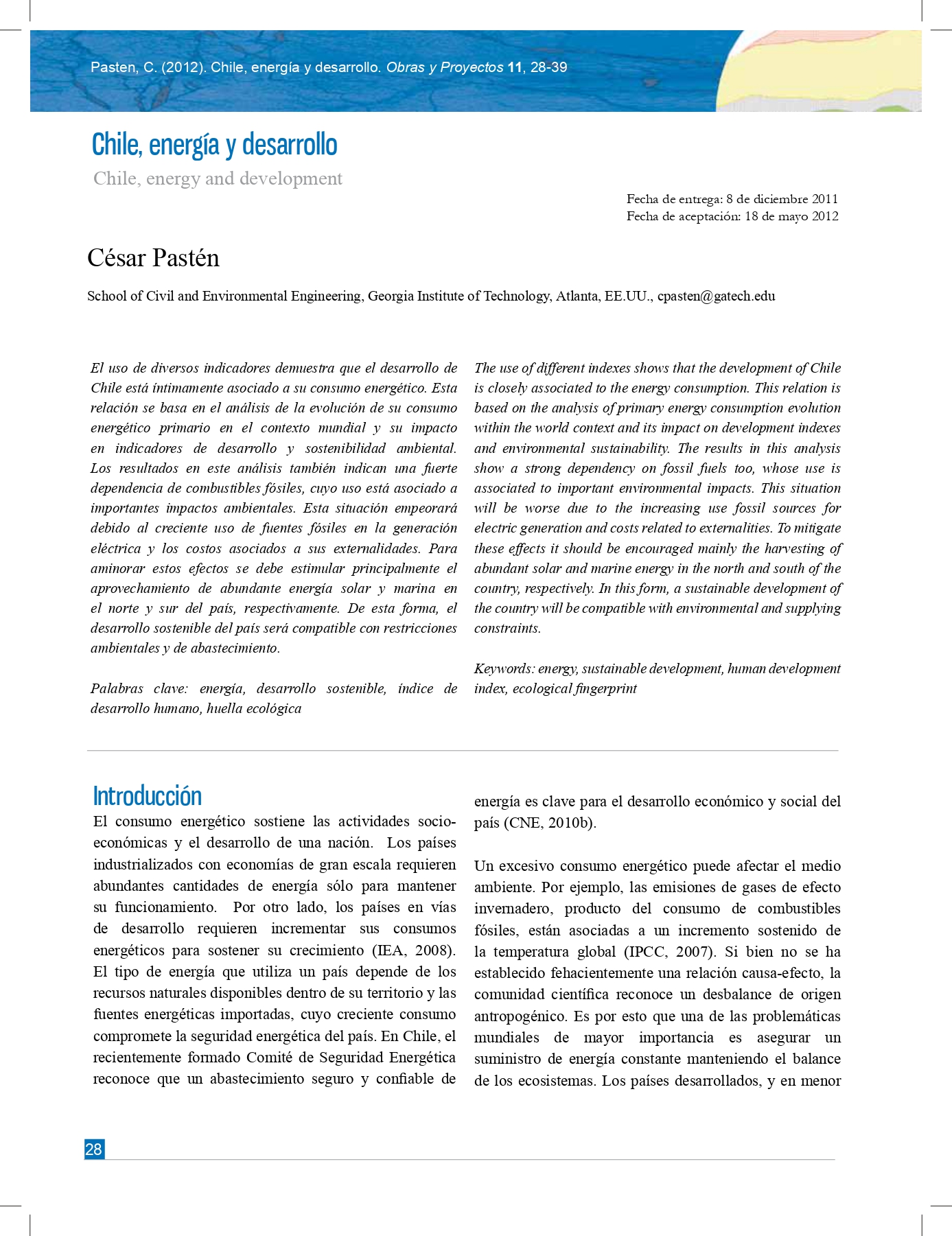Chile, energy and development
DOI:
https://doi.org/10.4067/S0718-28132012000100003Keywords:
energy, sustainable development, human development index, ecological fingerprintAbstract
The use of different indexes shows that the development of Chile is closely associated to the energy consumption. This relation is based on the analysis of primary energy consumption evolution within the world context and its impact on development indexes and environmental sustainability. The results in this analysis show a strong dependency on fossil fuels too, whose use is associated to important environmental impacts. This situation will be worse due to the increasing use fossil sources for electric generation and costs related to externalities. To mitigate these effects it should be encouraged mainly the harvesting of abundant solar and marine energy in the north and south of the country, respectively. In this form, a sustainable development of the country will be compatible with environmental and supplying constraints.
References
Bemis, G. R. and De Angelis, M. (1990). Levelized cost of electricity generation technologies. Contemporary Economic Policy 8, No. 3, 200-214. https://doi.org/10.1111/j.1465-7287.1990.tb00654.x
CEPAL (2009). La economía del cambio climático en Chile -Síntesis. Naciones Unidas, Santiago, Chile.
CNE (2009). Modelación del recurso solar y eólico del norte de Chile. Comisión Nacional de Energía, Santiago, Chile.
CNE (2010a). Balances energéticos. Comisión Nacional de Energía. http://www.cne.cl/estadisticas/balances-energeticos. Acceso: 15 de Septiembre de 2011.
CNE (2010b). Ministro Raineri forma comité de seguridad energética. Comisión Nacional de Energía, http://www.cne.cl/noticias/otros/301-ministro-raineri-forma-comite-de-seguridad-energetica. Acceso: 16 de Septiembre de 2011.
CNE, PNUD y UTFSM (2008). Irradiancia solar en territorios de la República de Chile - Registro Solarimétrico. Comisión Nacional de Energía, Programa de las Naciones Unidas para el Desarrollo y Universidad Técnica Federico Santa María, Santiago, Chile.
CNEC (2009). Análisis relativo de impactos y riesgos de la generación núcleo-eléctrica. Corporación Nuclear Eléctrica de Chile S.A., Santiago, Chile.
Cruz, J., Thomson, M. D. and Stavroulia, E. (2009). Preliminary site selection - Chilean marine energy resources. Garrad Hassan and Partners Limited.
EIA (2010). International energy statistics, U.S. Energy Information Administration. http://www.tonto.eia.doe.gov/cfapps/ipdbproject/IEDIndex3.cfm7tid=44 & pid=44 & aid=2. Acceso: 15 de Septiembre de 2011.
Ewing, B., Goldfinger, S., Wackernagel, M., Stechbart, M., Rizk, S. M., Reed, A. and Kitzes, J. (2008). The ecological footprint atlas 2008. Global Footprint Network, Oakland.
Holthuijsen, L. (2007). Waves in oceanic and coastal waters. Cambridge University Press, New York.
IEA (2008). International energy outlook 2008. International Energy Agency and Organization for Economic Cooperation and Development, Paris, France.
INE (2003). Censo 2002: Resultados - Volumen I. Instituto Nacional de Estadísticas de Chile.
IPCC (2007). Climate change 2007: Synthesis report. Intergovernmental Panel on Climate Change.
Khaligh, A. and Onar, O. (2010). Energy harvesting: solar, wind, and ocean energy conversion systems. CRC Press, Boca Raton, Florida.
Kozulj, R. (2005). Crisis de la industria del gas natural en Argentina. CEPAL, Naciones Unidas, Santiago, Chile.
Lynn, P. (2010). Electricity from Sunlight: An Introduction to Photovoltaics. John Wiley & Sons Ltd., Chichester, West Sussex, UK.
Masters, G. M. (2004). Renewable and efficient electric power systems. John Wiley & Sons, Inc., Hoboken, New Jersey, USA.
Monárdez, P., Acuña, H. and Scott, D. (2008). Evaluation of the potential of wave energy in Chile. 27th International Conference on Offshore Mechanics and Arctic Engineering, ASME, Estoril, Portugal.
Morata, D. (2011). Energía geotérmica en Chile: un desafío urgente para el país, Santiago. http://www.elmostrador.cl/opinion/2011/03/27/energia-geotermica-en-chile-un-desafio-urgente-para-el-pais/. Acceso: 17 de Mayo de 2012.
O'Ryan, R. (2008). Diseño de un modelo de proyección de demanda energética global nacional de largo plazo. Informe final preparado para la Comisión Nacional de Energía. Programa de Gestión y Economía Ambiental, Departamento de Ingeniería Industrial, Universidad de Chile.
Pasten, C. and Santamarina, J. C. (2010). Energy geo-storage. KSCE Journal of Civil Engineering 15, No. 4, 655-667.
Pasten, C. and Santamarina, J. C. (2012). Energy and quality of life. Energy Policy (aceptado).
PNUD (2010). Informe sobre desarrollo humano 2010. Edición del vigésimo aniversario. La verdadera riqueza de las naciones: Caminos al desarrollo humano. Programa de las Naciones Unidas para el Desarrollo.
Raineri, R. and Contreras, G. (2010). Efficient capacity investment and joint production agreements in an oligopolistic electricity market: The HidroAysen joint venture project. Energy Policy 38, No. 11, 6551-6559.
Roth, I. F. and Ambs, L. L. (2004). Incorporating externalities into a full cost approach to electric power generation life-cycle costing. Energy 29, No. 12-15, 2125-2144. https://doi.org/10.1016/j.energy.2004.03.016
Rudnick, H. (2006). Seguridad energética en Chile: dilemas, oportunidades y peligros. Vicerrectoría de Comunicaciones y Asuntos Públicos, Pontificia Universidad Católica de Chile, Santiago.
Santamarina, J. C. (2006). The worldwide energy situation. Anales de la Academia Nacional de Ingeniería República de Argentina, Tomo II, 79-98.
SEA (2010). Servicio de evaluación ambiental - Búsqueda de proyectos. Servicio de Evaluación Ambiental. http://seia.sea.gob.cl/busqueda/buscarProyecto.php. Acceso: 16 de Octubre de 2011.
UNDP (2010a). The human development index (HDI). United Nations Development Program. http://www.hdr.undp.org/en/statistics/hdi/. Acceso: 23 de Octubre de 2011.
UNDP (2010b). Human development index (HDI) value. United Nations Development Program. http://www.hdrstats.undp.org/en/indicators/49806.html. Acceso: 23 de Octubre de 2011.
Vestas (2008). Catalogue V82-1.65 MW. http://www.vestas.com, Denmark.
WB (2010). CO2 emissions (metric tons per capita) The World Bank. http://www.data.worldbank.org/indicator/EN.ATM.CO2E.PC. Acceso: 23 de Octubre de 2011.
Weisser, D. (2007). A guide to life-cycle greenhouse gas (GHG) emissions from electric supply technologies. Energy 32, No. 9,. 1543-1559. https://doi.org/10.1016/j.energy.2007.01.008

Downloads
Published
Issue
Section
License
Copyright (c) 2012 Universidad Católica de la Santísima Concepción

This work is licensed under a Creative Commons Attribution-NonCommercial 4.0 International License.







